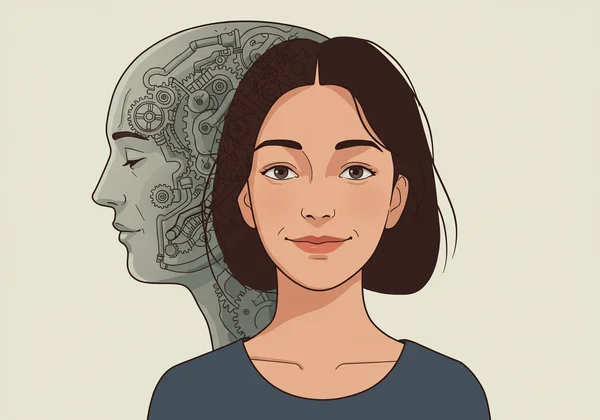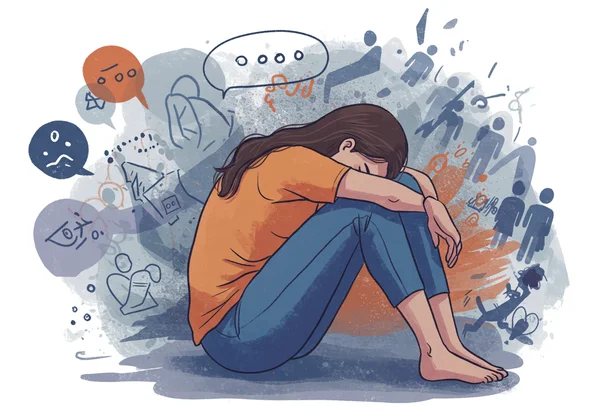CATQ & การอำพรางตัวในผู้หญิงออทิสติก: ทำไมหลายคนจึงไม่ได้รับการวินิจฉัย
คุณใช้ชีวิตด้วยความรู้สึกเหมือนเป็นคนนอกที่คอยมองดูอยู่เสมอหรือไม่? การรวมกลุ่มทางสังคมทำให้คุณรู้สึกอ่อนเพลียอย่างสิ้นเชิง ราวกับว่าคุณเพิ่งวิ่งมาราธอนจบ? สำหรับผู้หญิงจำนวนนับไม่ถ้วน ความรู้สึกของการสวมบทบาทแทนที่จะใช้ชีวิตอย่างแท้จริงเป็นความจริงประจำวัน คุณอาจกำลังประสบกับการอำพรางตัวของผู้เป็นออทิสติก (autistic camouflaging) ซึ่งเป็นเหตุผลหลักที่ทำให้ผู้หญิงและเด็กหญิงออทิสติกจำนวนมากไม่ได้รับการวินิจฉัย หากคุณเคยสงสัยว่า "ฉันจะเป็นออทิสติกโดยที่ตัวเองไม่รู้ตัวได้ไหม โดยเฉพาะในฐานะผู้หญิง?" คุณไม่ได้อยู่คนเดียว บทความนี้จะสำรวจประสบการณ์การอำพรางตัวที่เป็นเอกลักษณ์ของผู้หญิง เหตุผลที่การวินิจฉัยแบบดั้งเดิมมักไม่สามารถวินิจฉัยได้ และการทำความเข้าใจพฤติกรรมเหล่านี้ผ่านเครื่องมืออย่าง CATQ สามารถเป็นก้าวแรกสู่การค้นพบตนเองที่ลึกซึ้ง การเดินทางแห่งความเข้าใจนี้สามารถเริ่มต้นได้แล้ววันนี้ แบบทดสอบออนไลน์ฟรี (free online test) สามารถให้ภาพแรกของความกระจ่างได้
ทำความเข้าใจผู้หญิงออทิสติก & พฤติกรรมการอำพรางตัว (Masking Behaviors)
การพูดคุยเรื่องออทิสติกในอดีตมักถูกครอบงำด้วยลักษณะอาการที่เน้นในเพศชาย สิ่งนี้ได้สร้างช่องว่างที่สำคัญในการทำความเข้าใจ ทำให้ผู้หญิงหลายคนรู้สึกไร้ตัวตน การอำพรางตัวของผู้เป็นออทิสติก หรือการพรางตัว (camouflaging) เป็นสิ่งที่พบได้บ่อยเป็นพิเศษในผู้หญิง ซึ่งมักถูกปลูกฝังทางสังคมตั้งแต่ยังเด็กให้มีความโอนอ่อนผ่อนตาม เข้าใจผู้อื่นได้ดี และตระหนักรู้ทางสังคมมากขึ้น แรงกดดันนี้สามารถนำไปสู่การพัฒนากลไกการรับมือที่ซับซ้อนเพื่อซ่อนลักษณะเฉพาะของผู้เป็นออทิสติก ไม่เพียงแต่จากผู้อื่น แต่บ่อยครั้งก็จากตัวเองด้วย

การอำพรางตัวของผู้เป็นออทิสติกคืออะไร และส่งผลกระทบอย่างไร?
การอำพรางตัวของผู้เป็นออทิสติก คือการระงับลักษณะเฉพาะของผู้เป็นออทิสติกโดยเจตนาหรือไม่เจตนาก็ตาม เพื่อให้เข้ากับความคาดหวังทางสังคมของคนทั่วไป มันเป็นมากกว่าแค่การทำเป็นเข้มแข็ง มันคือชุดกลยุทธ์ที่ซับซ้อนซึ่งแบ่งออกเป็นสามประเภทหลัก:
- การชดเชย (Compensation): สิ่งนี้เกี่ยวข้องกับการเรียนรู้และนำกฎเกณฑ์ทางสังคมมาใช้อย่างจริงจัง มันเหมือนกับการเตรียมตัวสอบที่คุณไม่เคยรู้ว่ามี คุณอาจดูภาพยนตร์เพื่อเรียนรู้การแสดงออกทางสีหน้า ฝึกสนทนาในใจ หรือเตรียมบทสนทนาสำหรับการปฏิสัมพันธ์ทางสังคม
- การปิดบัง (Masking): นี่คือการซ่อนพฤติกรรมของผู้เป็นออทิสติกโดยตรง มันอาจหมายถึงการบังคับตัวเองให้สบตาแม้ว่ามันจะเจ็บปวด การระงับพฤติกรรมการกระตุ้นตัวเอง (stimming behaviors) เช่น การตบมือ หรือการโยกตัว และการแสร้งทำเป็นสนใจในหัวข้อที่คุณไม่เห็นด้วย
- การปรับตัวกลมกลืน (Assimilation): กลยุทธ์นี้เกี่ยวข้องกับการพยายามกลมกลืนไปกับผู้อื่นโดยการเลียนแบบพฤติกรรมของคนรอบข้าง คุณอาจรับเอากิริยาท่าทาง โทนเสียง หรือแม้กระทั่งความคิดเห็นของคนรอบข้างเพื่อหลีกเลี่ยงการเป็นจุดสนใจ
แม้ว่ากลยุทธ์เหล่านี้สามารถช่วยให้เอาตัวรอดทางสังคมในระยะสั้นได้ แต่ผลกระทบในระยะยาวมักจะเลวร้าย การใช้พลังงานสมองอย่างต่อเนื่องสามารถนำไปสู่โรควิตกกังวลเรื้อรัง ภาวะซึมเศร้า การสูญเสียตัวตน และความเหนื่อยล้าอย่างรุนแรงที่เรียกว่า ภาวะหมดไฟจากออทิสติก (autistic burnout)
เหตุใดผู้หญิงจึงมักไม่ได้รับการวินิจฉัยว่าเป็นออทิสติก
ภาพลักษณ์คลาสสิกของออทิสติก ซึ่งมักเน้นไปที่เด็กชายที่มีปัญหาด้านการสื่อสารทางสังคมที่ชัดเจนและมีความสนใจที่มุ่งเน้นเป็นพิเศษนั้น ไม่สอดคล้องกับประสบการณ์ของเด็กหญิงและผู้หญิงหลายคน การวิจัยและการปฏิบัติทางคลินิกกำลังค่อยๆ ตามทัน แต่เป็นเวลาหลายทศวรรษที่เกณฑ์การวินิจฉัยได้มองข้ามการแสดงออกที่ละเอียดอ่อนซึ่งพบได้ทั่วไปในเพศหญิง เด็กหญิงออทิสติกจำนวนมากมีความสนใจพิเศษที่ "เป็นที่ยอมรับทางสังคม" เช่น วรรณกรรม ศิลปะ หรือสัตว์ ซึ่งไม่ได้ถูกระบุว่าผิดปกติ พวกเธอมักถูกอธิบายว่าเป็น "คนขี้อาย" "อ่อนไหว" หรือ "คนฝันกลางวัน" แทนที่จะได้รับการประเมินว่าเป็นผู้มีความหลากหลายทางระบบประสาท รูปแบบของการถูกเข้าใจผิดนี้นำไปสู่ อัตราผู้ใหญ่ที่ไม่ได้รับการวินิจฉัยว่าเป็นออทิสติก ในระดับสูง โดยเฉพาะผู้หญิงที่ใช้เวลาทั้งชีวิตในการพัฒนาการอำพรางตัวให้สมบูรณ์แบบ
ลักษณะทั่วไปของผู้หญิงออทิสติก & สัญญาณของการอำพรางตัว
การรับรู้สัญญาณของการอำพรางตัวเป็นก้าวแรกสู่การทำความเข้าใจตัวตนที่แท้จริงของคุณ พฤติกรรมเหล่านี้มักฝังรากลึกเสียจนคุณอาจไม่รู้ตัวว่ากำลังทำมันอยู่ มันได้กลายเป็นวิธีปกติของคุณในการนำทางโลกที่อาจรู้สึกสับสนและท่วมท้น หากคุณรู้สึกเหมือนกำลังสวมบทบาทอยู่ตลอดเวลา อาจถึงเวลาที่ต้องพิจารณาบทบาทที่คุณสวมให้ละเอียดยิ่งขึ้น
การระบุสัญญาณที่ละเอียดอ่อนของการอำพรางและการชดเชย
นอกเหนือจากหมวดหมู่ที่กว้างขึ้นแล้ว ประสบการณ์ชีวิตของการอำพรางตัวยังเกี่ยวข้องกับพฤติกรรมเฉพาะหลายอย่าง การสำรวจรูปแบบของคุณเองสามารถช่วยยืนยันความรู้สึกของคุณได้อย่างมาก นี่คือตัวอย่างทั่วไปของ กลยุทธ์การชดเชยในผู้เป็นออทิสติก:
- การสร้างบทสนทนา (Scripting Conversations): คุณมีการซักซ้อมบทสนทนาในใจก่อนที่จะเกิดขึ้นหรือไม่ โดยวางแผนคำถามและคำตอบของคุณ?
- การเลียนแบบผู้อื่น (Mirroring Others): คุณพบว่าตัวเองรับเอากิริยาท่าทาง สำเนียง หรือคำพูดของคนที่คุณกำลังพูดด้วยหรือไม่?
- การบังคับสัญญาณทางสังคม (Forcing Social Cues): คุณเตือนตัวเองอย่างมีสติที่จะพยักหน้า ยิ้ม หรือสบตาในระหว่างการสนทนาหรือไม่?
- การใช้เหตุผลกับอารมณ์ (Intellectualizing Emotions): คุณวิเคราะห์อารมณ์อย่างมีเหตุผล แทนที่จะรู้สึกมันอย่างลึกซึ้ง บางทีอาจอาศัยระบบกฎเกณฑ์เพื่อรู้ว่าจะตอบสนองอย่างไร?
- การสร้าง "ตัวตนทางสังคม" (Creating a "Social Persona"): คุณมีตัวตนที่แตกต่างกันสำหรับที่ทำงาน เพื่อน และครอบครัว โดยแต่ละตัวตนได้รับการปรับแต่งให้เข้ากับความคาดหวังของพวกเขาหรือไม่?
การทำความเข้าใจ masking vs assimilation autism เป็นสิ่งสำคัญ; การปิดบัง (masking) คือการซ่อนตัวตนที่แท้จริงของคุณ ในขณะที่การปรับตัวกลมกลืน (assimilation) คือการรับเอาตัวตนของผู้อื่นมาใช้ ทั้งสองอย่างล้วนเป็นความพยายามที่เหนื่อยล้าเพื่อให้เข้ากับผู้อื่น เครื่องมืออย่าง มาตรวัดการอำพรางตัวทางสังคม สามารถช่วยให้คุณวัดปริมาณพฤติกรรมเหล่านี้ได้ เปลี่ยนความรู้สึกที่คลุมเครือให้กลายเป็นข้อมูลที่เป็นรูปธรรม
ผลกระทบทางอารมณ์และร่างกายจากการแสดงตัวตนตลอดเวลา
การใช้ชีวิตหลังม่านบังตามาพร้อมกับต้นทุนที่มหาศาล แรงกดดันอย่างต่อเนื่องในการแสดงออกตามแบบผู้มีพัฒนาการปกติสามารถนำไปสู่ ภาวะหมดไฟจากออทิสติก (autistic burnout) ซึ่งเป็นภาวะที่ร่างกาย จิตใจ และอารมณ์เหนื่อยล้าอย่างรุนแรง มันไม่ใช่แค่ความรู้สึกเหนื่อยล้า แต่เป็นการปิดระบบโดยสมบูรณ์ที่เกิดจากความเครียดสะสมจากการปรับตัวกับโลกที่ไม่ได้รับการออกแบบมาเพื่อคุณ

อาการของภาวะหมดไฟจากออทิสติกอาจรวมถึง:
- ความเหนื่อยล้าเรื้อรังและอ่อนเพลียที่การนอนหลับไม่สามารถแก้ไขได้
- ความไวต่อการรับสัมผัสที่เพิ่มขึ้นต่อแสง เสียง หรือสัมผัส
- การสูญเสียทักษะ รวมถึงความสามารถทางสังคมที่เคยจัดการได้
- ความบกพร่องในการบริหารจัดการ (Executive dysfunction) ทำให้การวางแผนและการตัดสินใจรู้สึกเป็นไปไม่ได้
- การถอนตัวจากสังคมอย่างรุนแรงและความต้องการความสันโดษสูงสุดเพื่อฟื้นฟู
หากสิ่งเหล่านี้ฟังดูคุ้นเคย จงรู้ไว้ว่าคุณไม่ได้ผิดปกติหรือล้มเหลว คุณเป็นมนุษย์ที่แบกรับภาระอันยิ่งใหญ่ การรับรู้ถึงผลกระทบนี้เป็นก้าวแรกในการอนุญาตให้ตัวเองได้พักผ่อนและเยียวยา
การยอมรับประสบการณ์ของผู้หญิงที่มีความหลากหลายทางระบบประสาท (Neurodivergent Woman)
การค้นพบว่าคุณอาจเป็นออทิสติกและได้อำพรางตัวมาตลอดชีวิต อาจเป็นพายุแห่งอารมณ์—ความโล่งใจ ความโศกเศร้า ความโกรธ และในที่สุดคืออิสรภาพ ความรู้นี้ไม่ใช่ป้ายที่จะจำกัดคุณ แต่มันคือ กุญแจ ที่ไขไปสู่ความเข้าใจที่ลึกซึ้งยิ่งขึ้นว่าคุณเป็นใคร มันคือการเชิญชวนให้เริ่มใช้ชีวิตอย่างเป็นตัวของตัวเองมากขึ้น ตามเงื่อนไขของคุณเอง
ก้าวสู่ความเป็นตัวของตัวเองและการยอมรับตนเอง
การเลิกปิดบัง (Unmasking) เป็นกระบวนการส่วนบุคคลและค่อยเป็นค่อยไป มันไม่ใช่การละทิ้งกลไกการรับมือทั้งหมดของคุณในทันที แต่เป็นการเลือกอย่างมีสติว่าเมื่อใดและที่ไหนที่จะใช้มัน แทนที่จะทำไปโดยอัตโนมัติ มันเริ่มต้นด้วยความเมตตาต่อตนเอง (self-compassion) และการอนุญาตให้ตัวเองเป็นตัวเอง สิ่งนี้อาจหมายถึงการอนุญาตให้ตัวเองกระตุ้นตัวเอง (stim) เมื่อรู้สึกเครียด การปฏิเสธคำเชิญทางสังคมโดยไม่รู้สึกผิด หรือการแบ่งปันความสนใจที่แท้จริงของคุณกับเพื่อนที่ไว้ใจได้ การเดินทางสู่ความเป็นตัวของตัวเองนี้เป็นรูปแบบหนึ่งของการดูแลตนเองที่ทรงพลังที่สุด หากคุณพร้อมที่จะสำรวจรูปแบบเหล่านี้ คุณสามารถ เริ่มต้นการเดินทางของคุณ ด้วยการประเมินตนเองอย่างเป็นความลับ
CATQ Test ช่วยสนับสนุนการเดินทางเพื่อค้นหาตนเองของคุณได้อย่างไร
ดังนั้น คุณจะเริ่มถอดรหัสพฤติกรรมที่เรียนรู้มาตลอดชีวิตได้อย่างไร? แบบสอบถามการวัดลักษณะการอำพรางตัวของผู้เป็นออทิสติก (Camouflaging Autistic Traits Questionnaire - CATQ) เป็นเครื่องมือที่ผ่านการตรวจสอบทางวิทยาศาสตร์ (scientifically validated tool) ซึ่งออกแบบมาโดยเฉพาะเพื่อวัดพฤติกรรมเหล่านี้ CATQ test ไม่ใช่เครื่องมือในการวินิจฉัย แต่เป็นทรัพยากรที่ทรงพลังอย่างยิ่งสำหรับการสำรวจตนเอง ด้วยการตอบคำถาม 25 ข้อที่ออกแบบมาอย่างรอบคอบ คุณสามารถได้รับภาพที่ชัดเจนขึ้นเกี่ยวกับสไตล์การอำพรางตัวที่เป็นเอกลักษณ์ของคุณ

บนแพลตฟอร์มของเรา คุณสามารถ ทำแบบทดสอบ CATQ ฟรี และรับคะแนนทันทีในสามระดับย่อย (sub-scales): การชดเชย (Compensation), การปิดบัง (Masking) และการปรับตัวกลมกลืน (Assimilation) สำหรับผู้ที่ต้องการความเข้าใจที่ลึกซึ้งยิ่งขึ้น เรามีรายงานส่วนบุคคลที่ขับเคลื่อนด้วย AI ซึ่งเป็นทางเลือก รายงานนี้จะไปไกลกว่าแค่ตัวเลข โดยให้ข้อมูลเชิงลึกโดยละเอียดเกี่ยวกับจุดแข็ง ความท้าทาย และรูปแบบการอำพรางตัวของคุณอาจส่งผลกระทบต่อชีวิตประจำวันของคุณอย่างไร โดยนำเสนอขั้นตอนที่นำไปปฏิบัติได้จริงสู่การดำรงชีวิตที่เป็นตัวของตัวเองมากขึ้น
เปิดเผยตัวตนที่แท้จริงของคุณ: เส้นทางสู่ความเข้าใจ
เส้นทางของผู้หญิงออทิสติกที่ไม่ได้รับการวินิจฉัยมักเป็นเส้นทางที่โดดเดี่ยว เต็มไปด้วยความสับสนและความเหนื่อยล้า แต่มันไม่จำเป็นต้องเป็นเช่นนั้นเสมอไป การทำความเข้าใจการอำพรางตัวของผู้เป็นออทิสติกเป็นการยืนยันประสบการณ์เหล่านี้ และมอบกรอบการทำงานใหม่สำหรับตัวตนของคุณ เป็นการตีความความท้าทายตลอดชีวิตใหม่ ไม่ใช่ความล้มเหลวส่วนบุคคล แต่เป็นการพิสูจน์ถึงความยืดหยุ่นและความแข็งแกร่งของคุณ
การเดินทางเพื่อค้นพบตนเองของคุณเป็นของคุณเอง หากบทความนี้โดนใจคุณ เราขอเชิญชวนให้คุณก้าวต่อไป เยี่ยมชม CATQ.org เพื่อทำ CATQ online test ที่ฟรีและเป็นความลับ ให้มันเป็นเครื่องมือที่ส่องสว่างเส้นทางของคุณสู่การยอมรับตนเอง และชีวิตที่สมบูรณ์และเติมเต็มยิ่งขึ้น
ข้อจำกัดความรับผิดชอบ: บทความนี้มีวัตถุประสงค์เพื่อให้ข้อมูลเท่านั้น และไม่ใช่สิ่งทดแทนคำแนะนำทางการแพทย์ การวินิจฉัย หรือการรักษาจากผู้เชี่ยวชาญ CATQ เป็นเครื่องมือประเมินตนเองเพื่อการสำรวจตนเอง และไม่ได้มีไว้สำหรับการวินิจฉัยทางคลินิก ควรขอคำแนะนำจากผู้ให้บริการด้านสุขภาพที่มีคุณสมบัติเสมอ หากมีคำถามใดๆ เกี่ยวกับภาวะทางการแพทย์
คำถามที่พบบ่อยเกี่ยวกับพฤติกรรมการอำพรางตัวในผู้หญิงออทิสติก
ฉันจะรู้ได้อย่างไรว่าฉันกำลังอำพรางตัวจากออทิสติก?
คุณอาจกำลังอำพรางตัวหากคุณรู้สึกเหนื่อยล้าอย่างต่อเนื่องหลังจากการปฏิสัมพันธ์ทางสังคม วางแผนอย่างพิถีพิถันว่าจะพูดอะไร เลียนแบบภาษากายของผู้อื่นอย่างมีสติ หรือรู้สึกเหมือนกำลังสวมบทบาทเพื่อให้เข้ากับผู้อื่น หากคุณรู้สึกแปลกแยกจาก "การแสดง" ของคุณบ่อยครั้ง นั่นอาจเป็นสัญญาณของการอำพรางตัว
สัญญาณของการอำพรางตัวของผู้เป็นออทิสติกในผู้หญิงมีอะไรบ้าง?
สัญญาณทั่วไป ได้แก่ การมีเพื่อนสนิทที่เข้มข้นจำนวนน้อย แทนที่จะมีวงสังคมขนาดใหญ่ การพัฒนากลไกการรับมือที่ใช้เหตุผลอย่างมาก การประสบกับอารมณ์ที่รุนแรงภายในในขณะที่ภายนอกดูสงบ และการประสบกับโรควิตกกังวลหรือภาวะซึมเศร้าที่เกิดขึ้นร่วมด้วย หลายคนยังรายงานว่ามีโลกภายในที่ร่ำรวยซึ่งรู้สึกขัดแย้งกับบุคลิกภายนอกของตนเอง
ฉันจะเป็นออทิสติกโดยที่ตัวเองไม่รู้ตัวได้ไหม โดยเฉพาะในฐานะผู้หญิง?
แน่นอน ด้วยความคาดหวังทางสังคมที่แตกต่างกันตามเพศและเกณฑ์การวินิจฉัยที่ล้าสมัย ผู้หญิงออทิสติกจำนวนมากได้พัฒนากลยุทธ์การอำพรางตัวที่มีประสิทธิภาพมากเสียจนไม่ได้รับการวินิจฉัยจนกระทั่งเข้าสู่วัยผู้ใหญ่ตอนปลาย หลายคนได้รับการวินิจฉัยหลังจากมีลูกได้รับการวินิจฉัย หรือเมื่อพวกเธอถึงจุดที่หมดไฟอย่างสมบูรณ์ การประเมินตนเองด้วย CATQ สามารถเป็นขั้นตอนแรกที่เป็นประโยชน์ในการสำรวจความเป็นไปได้นี้
อะไรคือความแตกต่างระหว่างการอำพรางตัว (masking) กับความรู้สึกไม่สบายใจทางสังคม (social awkwardness)?
แม้ว่าทั้งสองอย่างอาจเกี่ยวข้องกับความยากลำบากทางสังคม แต่การอำพรางตัว (masking) คือกระบวนการที่ต้องใช้ความพยายามอย่างแข็งขันในการซ่อนตัวตนตามธรรมชาติของตนเองและแสดงตัวตนของผู้มีพัฒนาการปกติ มันมักนำไปสู่ความเหนื่อยล้าอย่างรุนแรงและความรู้สึกของการเป็นคนหลอกลวง ความรู้สึกไม่สบายใจทางสังคม (social awkwardness) โดยทั่วไปเป็นสภาวะที่เฉื่อยชากว่าของความอึดอัดหรือไม่สะดวกใจ หรือการทำผิดพลาดทางสังคมโดยไม่มีชั้นเชิงของการปกปิดที่ซับซ้อน การใช้มาตรวัดเชิงปริมาณ เช่น แบบทดสอบ CATQ สามารถช่วยชี้แจงว่าพฤติกรรมของคุณสอดคล้องกับการอำพรางตัวหรือไม่